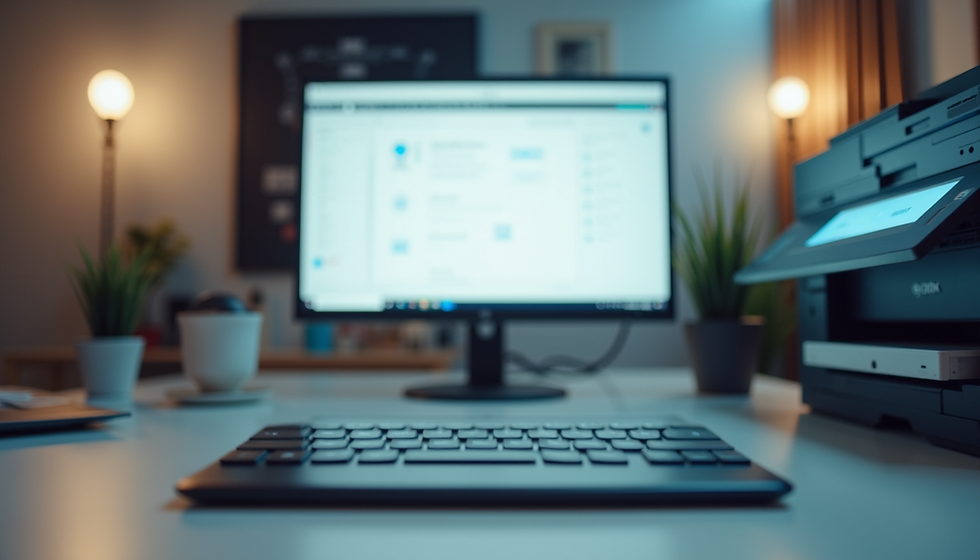Upgrading Your Workspace with Smart Technology
- Brad Blackmon
- Oct 3
- 4 min read
In today’s fast-paced world, upgrading your workspace with smart technology is no longer a luxury but a necessity. The integration of intelligent devices and systems can transform a traditional office into a highly efficient, comfortable, and productive environment. Whether you work from home or in a corporate setting, smart technology offers solutions that streamline tasks, enhance communication, and improve overall workflow.
Smart technology in the office is about more than just gadgets; it’s about creating a digital office that adapts to your needs and helps you work smarter, not harder. This post explores practical ways to upgrade your workspace with smart technology, providing actionable tips and examples to help you get started.
Why Smart Technology is Essential for a Modern Digital Office
Upgrading your workspace with smart technology means embracing tools that automate routine tasks, improve connectivity, and foster collaboration. The modern digital office is designed to be flexible and responsive, allowing employees to focus on what matters most.
Key benefits include:
Increased productivity: Smart devices reduce time spent on repetitive tasks.
Enhanced communication: Tools like smart conferencing systems improve remote collaboration.
Energy efficiency: Automated lighting and climate control save energy and reduce costs.
Better organization: Digital assistants and smart calendars help manage schedules seamlessly.
For example, installing smart lighting systems that adjust based on natural light can create a comfortable environment that reduces eye strain and boosts focus. Similarly, voice-activated assistants can handle meeting reminders, emails, and even control other smart devices, freeing up valuable time.

Integrating Smart Devices for a Seamless Digital Office Experience
To create a truly smart workspace, it’s important to select devices that work well together and enhance your daily operations. Here are some essential smart devices and how they can be integrated:
1. Smart Desks and Chairs
Adjustable desks that can be controlled via smartphone apps allow users to switch between sitting and standing positions easily. Smart chairs with posture sensors provide feedback to improve ergonomics.
2. Voice-Activated Assistants
Devices like Amazon Echo or Google Nest can manage calendars, set reminders, and control other smart office equipment through voice commands.
3. Smart Conference Systems
High-quality video conferencing tools with AI-powered noise cancellation and automatic framing improve remote meetings.
4. Automated Climate Control
Smart thermostats learn your schedule and adjust temperatures accordingly, ensuring comfort while saving energy.
5. Wireless Charging Stations
Keep devices powered without cluttering your desk with cables.
When these devices are connected through a central hub or app, you can control your entire workspace environment effortlessly. This integration is a hallmark of a digital office, where technology works in harmony to support your workflow.

Enhancing Collaboration and Communication with Smart Technology
One of the biggest challenges in any office is maintaining effective communication, especially with remote or hybrid teams. Smart technology offers solutions that make collaboration easier and more efficient.
Smart Whiteboards and Interactive Displays
These tools allow team members to brainstorm and share ideas in real-time, whether they are in the office or working remotely. Changes are saved automatically and can be accessed later.
Cloud-Based Collaboration Platforms
Platforms like Microsoft Teams, Slack, or Google Workspace integrate with smart devices to provide seamless communication channels, file sharing, and project management.
AI-Powered Meeting Assistants
These assistants can transcribe meetings, highlight action items, and schedule follow-ups, reducing the administrative burden on employees.
Noise-Cancelling Smart Headphones
Ideal for open office environments, these headphones help maintain focus by blocking out distractions during calls or deep work sessions.
By leveraging these technologies, your digital office becomes a hub of connectivity, ensuring that everyone stays informed and engaged regardless of location.

Practical Tips for Implementing Smart Technology in Your Workspace
Upgrading your workspace doesn’t have to be overwhelming. Here are some practical steps to help you get started:
Assess Your Needs: Identify pain points in your current setup. Is it communication, ergonomics, or energy efficiency?
Start Small: Begin with one or two smart devices, such as a smart thermostat or voice assistant, and expand gradually.
Ensure Compatibility: Choose devices that can integrate with each other and your existing systems.
Train Your Team: Provide training sessions to help everyone get comfortable with new technology.
Monitor and Adjust: Regularly review how the technology is impacting productivity and make adjustments as needed.
Additionally, consider exploring digital office solutions that offer tailored smart technology packages designed to meet specific business needs. These solutions can simplify the upgrade process and ensure you get the most out of your investment.
Future-Proofing Your Workspace with Smart Technology
The pace of technological advancement means that today’s smart office devices will continue to evolve. To future-proof your workspace:
Choose scalable solutions: Opt for technology that can be updated or expanded.
Stay informed: Keep up with trends in smart office technology.
Prioritize security: Ensure all devices have strong security features to protect sensitive data.
Encourage feedback: Regularly ask employees for input on how technology is working for them.
By adopting a forward-thinking approach, your digital office will remain efficient and adaptable, ready to meet the challenges of tomorrow.
Creating a Comfortable and Productive Environment
Smart technology is not just about efficiency; it’s also about creating a workspace where people feel comfortable and motivated. Consider these enhancements:
Smart lighting: Adjust brightness and color temperature to reduce eye strain.
Air quality monitors: Ensure a healthy environment by tracking and improving air quality.
Personalized settings: Allow employees to customize their workspace environment through apps.
Break reminders: Use smart devices to encourage regular breaks and movement.
These small changes can have a big impact on well-being and productivity, making your digital office a place where people want to work.
Upgrading your workspace with smart technology is an investment in the future of work. By embracing the digital office, you create an environment that supports productivity, collaboration, and well-being. Start small, plan carefully, and watch your workspace transform into a smart, efficient hub that meets the demands of modern work life.




Comments